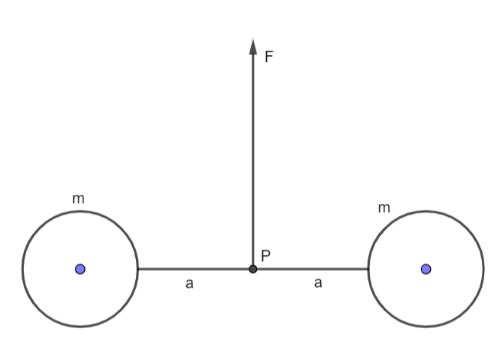
Two particles of mass m each are tied at the ends of a light string of length 2a. The whole system is kept on a frictionless horizontal surface with the string held tight so that each mass is at a distance a from the centre P (as shown in the figure). Now, the midpoint of the string is pulled vertically upwards with a small but constant force F. As a result, the particles move towards each other on the surface. Neglecting the earth's gravitation, the magnitude of acceleration, when the separation between them becomes 2x, is

A. $\dfrac{F}{{2m}}\dfrac{a}{{\sqrt {{a^2} - {x^2}} }}$
B. $\dfrac{F}{{2m}}\dfrac{x}{{\sqrt {{a^2} - {x^2}} }}$
C. $\dfrac{F}{{2m}}\dfrac{x}{a}$
D. $\dfrac{F}{{2m}}\dfrac{{\sqrt {{a^2} - {x^2}} }}{x}$

Answer
480.6k+ views
Hint:As soon as the string is pulled from the midpoint, tension is created that acts in the vertical direction while the acceleration is in the horizontal direction. Here we will first draw the free body diagram indicating all the forces in their respective directions. We will then calculate the applied force F in terms of tension T and express it in terms of the angle $\theta $ which is the angle between the stretched string and the reference line. We shall also write the force equation in the horizontal direction where the cosine component of tension acts. Making proper substitutions we will get the correct answer.
Complete step by step answer:
Let’s visualize the situation first and draw a free body diagram of the system.

Here a tension T acts along the string as it is stretched with the force F. We break the tension into its components in x and y directions respectively. $\theta $ is the angle between the stretched string and the reference line. The sine component acts in the vertical direction whereas the cosine component acts in the horizontal direction. However, the vertical components are both in the same direction. Hence, they will get added up.From the figure,
$\tan \theta = \dfrac{{\sqrt {{a^2} - {x^2}} }}{x}$
Hence, $\cot \theta = \dfrac{x}{{\sqrt {{a^2} - {x^2}} }}$
It is the sine component of the tension due to which the string gets pulled.
Hence, $F = 2T\sin \theta \,\,\,\,\,\,\,\,\,\,\,.......(1)$
The acceleration acts in the horizontal direction. Hence, we can say that
$T\cos \theta = ma$
where $m$ is the mass of the body.
From (1) we get,
$\dfrac{F}{{2\sin \theta }}\cos \theta = ma$
Rewriting this we get,
$ma = \dfrac{{F\cot \theta }}{2}$
$ \Rightarrow a = \dfrac{{F\cot \theta }}{{2m}}$
Substituting $\cot \theta = \dfrac{x}{{\sqrt {{a^2} - {x^2}} }}$ in this equation we get,
$\therefore a = \dfrac{F}{{2m}}\dfrac{x}{{\sqrt {{a^2} - {x^2}} }}$
Hence option B is the correct answer.
Note:In the question, it was mentioned that we have to neglect the gravitational pull. Had it not been mentioned, we had to consider the components of the gravitational force as well while calculating the force in the vertical and horizontal directions. The tension remains the same throughout the string because the mass density of the string is the same. When nothing is mentioned about the density variation in the string, we assume it to be a uniform string.
Complete step by step answer:
Let’s visualize the situation first and draw a free body diagram of the system.

Here a tension T acts along the string as it is stretched with the force F. We break the tension into its components in x and y directions respectively. $\theta $ is the angle between the stretched string and the reference line. The sine component acts in the vertical direction whereas the cosine component acts in the horizontal direction. However, the vertical components are both in the same direction. Hence, they will get added up.From the figure,
$\tan \theta = \dfrac{{\sqrt {{a^2} - {x^2}} }}{x}$
Hence, $\cot \theta = \dfrac{x}{{\sqrt {{a^2} - {x^2}} }}$
It is the sine component of the tension due to which the string gets pulled.
Hence, $F = 2T\sin \theta \,\,\,\,\,\,\,\,\,\,\,.......(1)$
The acceleration acts in the horizontal direction. Hence, we can say that
$T\cos \theta = ma$
where $m$ is the mass of the body.
From (1) we get,
$\dfrac{F}{{2\sin \theta }}\cos \theta = ma$
Rewriting this we get,
$ma = \dfrac{{F\cot \theta }}{2}$
$ \Rightarrow a = \dfrac{{F\cot \theta }}{{2m}}$
Substituting $\cot \theta = \dfrac{x}{{\sqrt {{a^2} - {x^2}} }}$ in this equation we get,
$\therefore a = \dfrac{F}{{2m}}\dfrac{x}{{\sqrt {{a^2} - {x^2}} }}$
Hence option B is the correct answer.
Note:In the question, it was mentioned that we have to neglect the gravitational pull. Had it not been mentioned, we had to consider the components of the gravitational force as well while calculating the force in the vertical and horizontal directions. The tension remains the same throughout the string because the mass density of the string is the same. When nothing is mentioned about the density variation in the string, we assume it to be a uniform string.
Recently Updated Pages
Master Class 11 Economics: Engaging Questions & Answers for Success

Master Class 11 English: Engaging Questions & Answers for Success

Master Class 11 Social Science: Engaging Questions & Answers for Success

Master Class 11 Biology: Engaging Questions & Answers for Success

Class 11 Question and Answer - Your Ultimate Solutions Guide

Master Class 11 Business Studies: Engaging Questions & Answers for Success

Trending doubts
What is meant by exothermic and endothermic reactions class 11 chemistry CBSE

10 examples of friction in our daily life

One Metric ton is equal to kg A 10000 B 1000 C 100 class 11 physics CBSE

Difference Between Prokaryotic Cells and Eukaryotic Cells

What are Quantum numbers Explain the quantum number class 11 chemistry CBSE

1 Quintal is equal to a 110 kg b 10 kg c 100kg d 1000 class 11 physics CBSE




